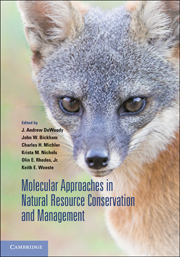Book contents
- Frontmatter
- Contents
- Contributors
- Preface
- 1 Biodiversity discovery and its importance to conservation
- 2 Gene flow, biodiversity, and genetically modified crops: Weedy rice in Thailand
- 3 A community and ecosystem genetics approach to conservation biology and management
- 4 Vertebrate sex-determining genes and their potential utility in conservation, with particular emphasis on fishes
- 5 Historical and contemporary dynamics of adaptive differentiation in European oaks
- 6 Association genetics, population genomics, and conservation: Revealing the genes underlying adaptation in natural populations of plants and animals
- 7 Hybridization in threatened and endangered animal taxa: Implications for conservation and management of biodiversity
- 8 Pollen and seed movement in disturbed tropical landscapes
- 9 Implications of landscape alteration for the conservation of genetic diversity of endangered species
- 10 Integrating evolutionary considerations into recovery planning for Pacific salmon
- 11 Using molecular methods to improve the genetic management of captive breeding programs for threatened species
- 12 Wildlife reintroductions: The conceptual development and application of theory
- 13 Evolutionary toxicology
- Index
- Plates
- References
9 - Implications of landscape alteration for the conservation of genetic diversity of endangered species
Published online by Cambridge University Press: 05 July 2014
- Frontmatter
- Contents
- Contributors
- Preface
- 1 Biodiversity discovery and its importance to conservation
- 2 Gene flow, biodiversity, and genetically modified crops: Weedy rice in Thailand
- 3 A community and ecosystem genetics approach to conservation biology and management
- 4 Vertebrate sex-determining genes and their potential utility in conservation, with particular emphasis on fishes
- 5 Historical and contemporary dynamics of adaptive differentiation in European oaks
- 6 Association genetics, population genomics, and conservation: Revealing the genes underlying adaptation in natural populations of plants and animals
- 7 Hybridization in threatened and endangered animal taxa: Implications for conservation and management of biodiversity
- 8 Pollen and seed movement in disturbed tropical landscapes
- 9 Implications of landscape alteration for the conservation of genetic diversity of endangered species
- 10 Integrating evolutionary considerations into recovery planning for Pacific salmon
- 11 Using molecular methods to improve the genetic management of captive breeding programs for threatened species
- 12 Wildlife reintroductions: The conceptual development and application of theory
- 13 Evolutionary toxicology
- Index
- Plates
- References
Summary
Humans have dramatically altered biotic communities around the world. During the process of converting forests, grasslands, and wetlands for agriculture, urban development, and transportation, the remnants of natural habitat have become increasingly fragmented. This fragmentation of habitat has many biological consequences. Foremost is the reduction of available habitat resulting in a reduced size of populations of species dependent on natural land covers (Andren 1994; Fahrig 1997, 2003). Fragmentation, though, is more than just habitat loss; it is also the division of remaining habitat into patches that experience at least partial isolation from other such fragments (Fahrig 2003). Fragmentation increases habitat edges and, consequently, the exposure of populations to the resulting alterations in microclimate and biota associated with edge environments (Suarez et al. 1998; Fagan et al. 1999). As fragments become more isolated, the frequency of movements between fragments is reduced. Furthermore, when localized extinctions in isolated fragments occur, immigration from neighboring fragments can be insufficient to allow recolonization (Tilman et al. 1994; Fahrig 2003). Extinctions associated with demographic stochasticity are expected to be more common in small fragments than in more continuous habitat tracts (Griffen & Drake 2008).
The consequences of fragmentation have the potential to influence genetic diversity in species requiring continuous tracts of habitat (see Chapter 8 by J. Hamrick). Localized population declines cause allele frequencies to drift; moreover, widespread population declines due to fragmentation across the range of a species may reduce its effective population size (Pannell & Charlesworth 2000; Alo & Turner 2005). With declines of census and effective population size, inhabitants of isolated fragments begin to resemble independent populations, become more vulnerable to stochastic processes, lose genetic diversity, and increase in relatedness (Barrowclough 1980; Leberg 2005).
- Type
- Chapter
- Information
- Publisher: Cambridge University PressPrint publication year: 2010
References
- 4
- Cited by



